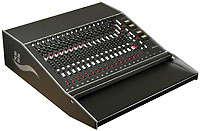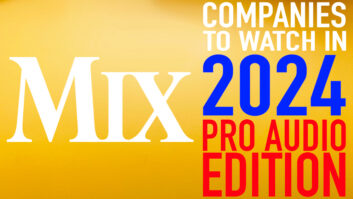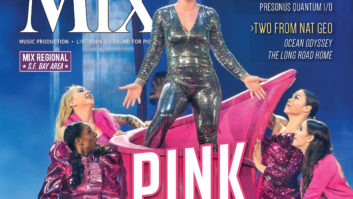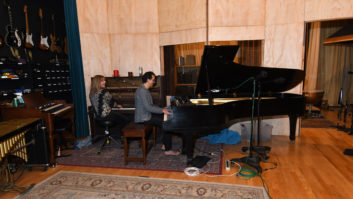
Harrison 950M Console
The 950m from Harrison (priced per configuration) is geared to meet the unique requirements of a DAW-based studio. It provides all features necessary to link professionals on both sides of the control room window. The console incorporates a massive linear power supply, robust ground-plane design, all balanced connections, gold-plated switches, through-hole components and high-headroom summing buses. It comes in three standard sizes: 12, 16 and 24-channel frames. There are two master buses: 1 “32-Series”-style transformer-balanced output, and one “Series 12”-style electroncially balanced output. Other features include two studio feeds, talkback, oscillator, headphone feeds, manual PCB layout, gold-plated switches, conductive plastic potentiometers and summing buses carried via PCBs (no ribbon cable summing buses).

KRK KNS Series Headphones
Voiced to remain true to the character of KRK’s studio monitors, the KNS6400 ($199) and KNS8400 ($249) Series professional headphones use the latest in acoustic memory-foam technology, promising top performance in reproduction and isolation. Features include high-efficiency neodymium drivers; 8.2-foot, single-sided straight cable with oxygen-free copper wires; and adjustable, foldable driver enclosures provide comfort and portability. The ¼-inch plug can be unscrewed to reveal an 1/8-inch plug for laptops and portable media players; the cable, head and ear cushions are replaceable to ensure product longevity. Both come with a soft carrying case embossed with the KRK logo for travel or storage when not in use.

Neumann KH 810 Subwoofer
The KH 810 ($TBA) from Neumann is a 7.1 High-Definition Bass Management™ system meant to team up with the KH 120 near-field two-way monitor. It can be used either as a subwoofer dedicated to reproducing the LFE channel or as a means of providing LF extension with an increased maximum SPL. The integrated 7.1 High Definition Bass Manager™ is compatible with all formats, from mono to the latest 7.1 high-definition systems. Eight electronically balanced analog XLR inputs ensure flexible interconnectivity. Four-mode LFE channel processing guarantees maximum compatibility across all formats, while fourth-order crossovers and flexible acoustic controls allow seamless system integration. Built-in volume control permits centralized system adjustment of replay levels, independent of the source. The electronics can be located remotely to reduce cabling and to allow the cabinet to be mounted flush to a wall.

CEDAR Cambridge Version 7
Based on the latest CEDAR Cambridge Series III hardware, Version 7 (free upgrade for Cambridge owners) boasts a hugely improved file-processing system; a powerful new module, Respeed; a unique new de-click algorithm, Manual Declick “B”; the introduction of Reporting; and dozens of improvements to existing modules, including Retouch, DNS, NR-4 and NR-5, the Adaptive Limiter and Vintage Decrackle. Other improvements include a Spectrogram view to augment the existing Waveform view, improved transport controls, improved channel mapping, the ability to perform transparent sample rate conversion while saving files, and the introduction of user-definable hot-keys, which allow operators to control the system from a keyboard and from devices such as foot pedals that map to the key commands.

Black Lion Sparrow mk2 A/D Converters
The completely redesigned Sparrow mk2 converters from Black Lion are housed in a 1U half-rack chassis and feature XLR and ¼-inch balanced inputs, LED metering, BNC word clock I/O, AES output, co-ax and optical S/PDIF output, and user-selectable signal calibration accommodating nominal input signal levels from +11 dBu down to -10 dBV. They operate at sampling rates from 44.1 kHz to 192 kHz, with a clocking architecture that features low jitter and wide Q third-harmonic crystal oscillators, and because of the quality of the clock multiplier and PLL recovery stages, performance will not degrade should the converter be synched to a lower-quality word clock reference. The units come in three versions: Black ($895), which is comparable to the conversion quality and sonic characteristics of the company’s Digi 002R/003R Signature Series modification; Red ($1,295), which is comparable to the FM192 modification; and White ($1,895), which outperforms the FM192 modified converters.

Pendulum DS-500 Opto De-esser
Pendulum Audio has made its second foray into the 500 Series game with the release of the DS-500 ($749.95) de-esser. The DS-500 is a single-channel, non-tube version of the de-esser in the Pendulum Quartet Tube Recording Channel. It uses the same inductive detector and opto-inductive notch filter as the de-esser in the Quartet, as well as very fast response. By pairing it with a unity gain Class-A solid-state line stage, the DS-500 retains the transparent character of the de-esser action while keeping the signal path clean and uncolored. The DS-500 is fully compatible with any rack that adheres to the API spec.

Primacoustic London 8, 10 Room Treatment Kits
Primacoustic has developed two room treatment kits. The London 8 ($199) is a starter kit that includes all the fundamental tools required to treat a home recording studio. This kit promises improved room acoustics, and more Primacoustic panels can be added at a later date as needs expand. The London 10 ($499) takes treatment to the next level by increasing the panel count for more control and adapts to larger spaces. All Primacoustic Broadway panels are made from premium 6-pound glass wool. Edges are resin treated, and the surfaces are encapsulated in micromesh. The panels are then covered in a durable acoustic fabric and offered in a choice of three colors. Each London kit comes complete with hanging hardware, screws and wall anchors.

AAS 4MinX Recorder/Mixer
The 4MinX ($5,795, 8-channel) multitrack recorder and mixer from AETA Audio Systems is powered by a DV-type Li-ion battery (7.2V, NP-F970) and has an integrated charger. It uses SDHC cards for recording, with the option of connecting external hard drives via a USB 2 port for greater storage capacity. Other features include file transfers via Ethernet, 48V phantom power, low-cut filter, analog I/O, 24-bit BWF file recording, AES3 and AES 42 digital inputs (AES3 output), M/S encoding/decoding, and timecode recording and synchronization. A 3-inch TFT color display provides information and menu choices; rotary encoders, soft buttons and four programmable buttons offer navigation and operation.
New Sound Reinforcement Products

Soundcraft Si Series Upgrade
The Soundcraft Si Series now offers more inputs on the Si1 and Si2 versions, plus added functionality and options. The Si1+ has 16 additional mic inputs fitted as standard, bringing the number of onboard mic inputs to 48 and processing capacity of 72 inputs to mix; the extra 16 mic input module may be replaced by an 8-in/8-out module if required. The number of option card slots increases to four, and there is now a space for an optional second (redundant) PSU. The Si2+ has the 16 mic input module as standard (also swappable with the 8-in/8-out module), which extends the onboard mic input count to 64, with an input-to-mix capacity of 80. All three models, including the Si3+, gain a word clock output connector, and all models can use the range of Si optional interface cards including MADI (optical or Cat-5), AES/EBU, CobraNet and Aviom A-Net.

Mackie ProFX16, ProFX22
Geared for mid-sized venues, the Mackie ProFX16 16-channel and PROFX22 22-channel mixers feature low-noise, high-headroom preamps with LED metering and 60mm faders on each channel. Each channel also offers 3-band EQ. Integrated 32-bit RMFX™ effects processor with 16 “gig-ready” FX and 7-band graphic EQ allow for tuning of mains or monitors. The built-in USB interface allows the user to record the show and stream back music for breaks or for integration into the mix. A solid-steel chassis with protective ABS sidecheeks offers impact resistance.

Avlex MIPRO ACT-82a
The new Avlex ACT-82a ($TBD) dual-channel encrypted digital diversity receiver offers expanded 120MHz bandwidth, second-generation DSP technology and 24-bit/44.1kHz audio quality. Carrier frequency range of UHF is 482 to 602 MHz. System latency is less than 2.9 ms, while THD is less than or equal to 0.04 percent @ 1 kHz. Audio frequency response extends from 20-20k Hz. For signal stability, it offers MIPRO’s DigitnamicPlus™ technology to eliminate compander noise, as well as integrated SmartEQ™ preset and user-defined mic capsule EQ. It is expected to be available Q3, 2011.

Powersoft M Series DSP+ETH
The new M Series DSP+ETH amplifiers provide access to Powersoft’s digital signal processing engine technology, Ethernet connectivity, and system monitoring and control through the company’s Armonía Pro Audio Suite™ software. The unit features 24-bit/48kHz AD/DA converters with 56-bit for internal processing. With two inputs and outputs each for the 2-channel version, and four inputs and outputs each for the 4-channel version, the system offers per-channel five bi-quad filters for system equalization, eliminating the need for outboard equalizers, plus two crossovers and eight bi-quad filters. Each channel has dual dynamic processors with arbitrary input/output curve and adjustable time constants. To accommodate speaker time alignment, a range from zero to 10ms adjustable delay makes timing the LF vs. HF speakers easy. The DSP engine delivers up to 114dB(A) signal-to-noise ratio with a 1ms processing delay time. It also provides such limiters as peak with variable ratio, RMS and frequency-shaping RMS.



